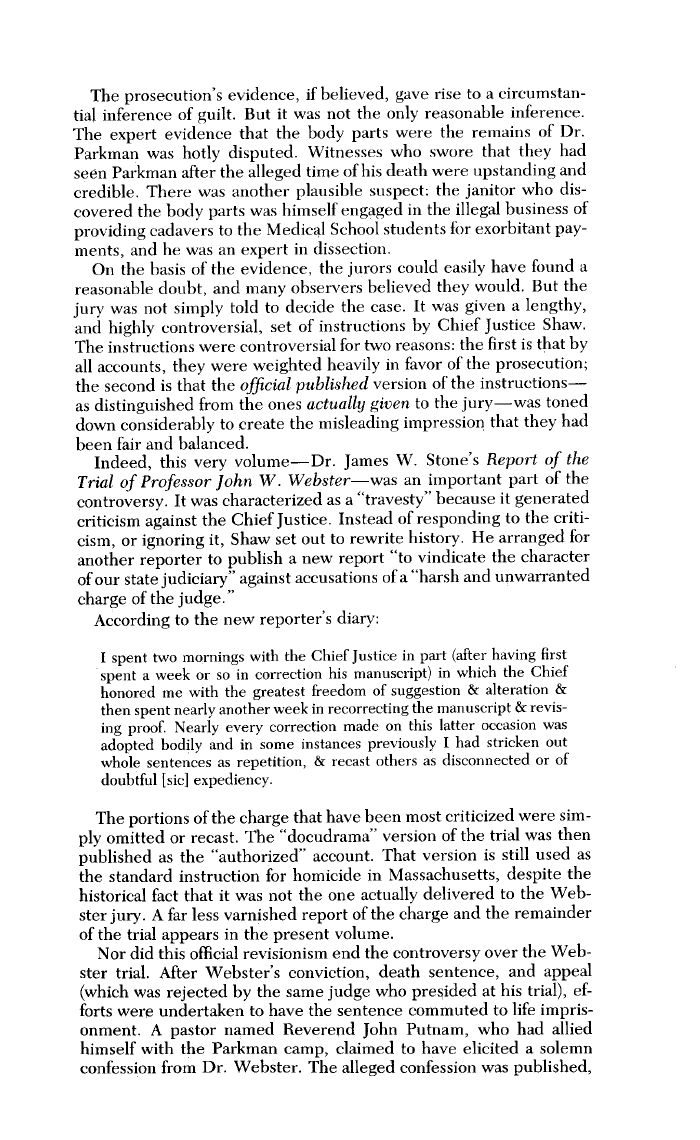|
The prosecution's evidence, if believed, gave rise to a circumstan-
tial inference of guilt. But it was not the only reasonable inference.
The expert evidence that the body parts were the remains of Dr.
Parkman was hotly disputed. Witnesses who swore that they had
seen Parkman after the alleged time of his death were upstanding and
credible. There was another plausible suspect: the janitor who dis-
covered the body parts was himself engaged in the illegal business of
providing cadavers to the Medical School students for exorbitant pay-
ments, and he was an expert in dissection.
On the basis of the evidence, the jurors could easily have found a
reasonable doubt, and many observers believed they would. But the
jury was not simply told to decide the case. It was given a lengthy,
and highly controversial, set of instructions by Chief Justice Shaw.
The instructions were controversial for two reasons: the first is that by
all accounts, they were weighted heavily in favor of the prosecution;
the second is that the official published version of the instructions-
as distinguished from the ones actually given to the jury-was toned
down considerably to create the misleading impression that they had
been fair and balanced.
Indeed, this very volume-Dr. James W. Stone's Report of the
Trial of Professor John W. Webster-was an important part of the
controversy. It was characterized as a "travesty" because it generated
criticism against the Chief justice. Instead of responding to the criti-
cism, or ignoring it, Shaw set out to rewrite history. He arranged for
another reporter to publish a new report "to vindicate the character
of our state judiciary" against accusations of a "harsh and unwarranted
charge of the judge."
According to the new reporter's diary:
I spent two mornings with the Chief justice in part (after having first
spent a week or so in correction his manuscript) in which the Chief
honored me with the greatest freedom of suggestion & alteration &
then spent nearly another week in recorrecting the manuscript & revis-
ing proof. Nearly every correction made on this latter occasion was
adopted bodily and in some instances previously I had stricken out
whole sentences as repetition, & recast others as disconnected or of
doubtful [sic] expediency.
The portions of the charge that have been most criticized were sim-
ply omitted or recast. The "docudrama" version of the trial was then
published as the "authorized" account. That version is still used as
the standard instruction for homicide in Massachusetts, despite the
historical fact that it was not the one actually delivered to the Web-
ster jury. A far less varnished report of the charge and the remainder
of the trial appears in the present volume.
Nor did this official revisionism end the controversy over the Web-
ster trial. After Webster's conviction, death sentence, and appeal
(which was rejected by the same judge who presided at his trial), ef-
forts were undertaken to have the sentence commuted to life impris-
onment. A pastor named Reverend John Putnam, who had allied
himself with the Parkman camp, claimed to have elicited a solemn
confession from Dr. Webster. The alleged confession was published,
|

